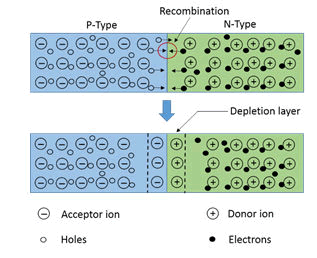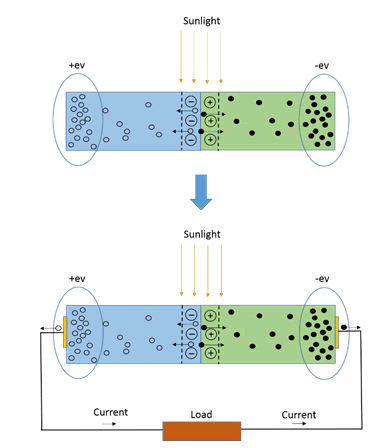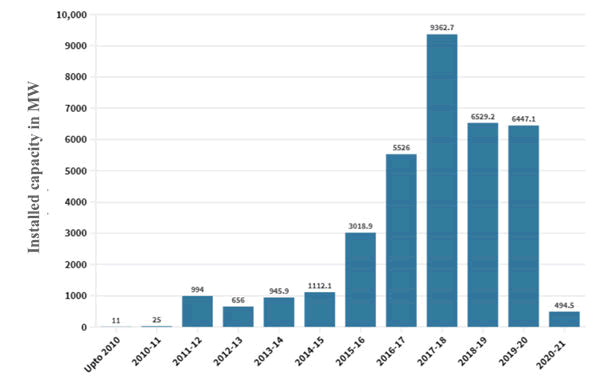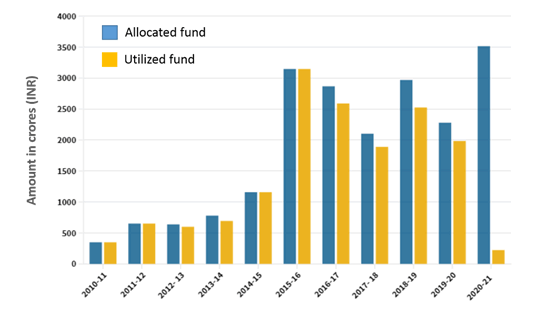Research Article, J Nucl Ene Sci Power Generat Technol Vol: 11 Issue: 2
An Overview of Status of Solar Power in India
Prasanna Mishra1*, Niladri Sekhar Roy1, Nitin Thapar2, Ajay Agrawal3
1Department of Environmental Science, SGT University, Haryana, India
2Department of Environmental Science, RIMT University, Punjab, India
3Department of Environmental Science, Sanskriti University, Uttar Pradesh, India
*Corresponding Author: Prasanna Mishra
Department of Computer Applications, PSG College of Technology, Coimbatore, India
E-mail: prasannamishra234@gmail.com
Received date: 29 January, 2022, Manuscript No. JNPGT-22-46152;
Editor assigned date: 31 January, 2022, PreQC No. JNPGT-22-46152(PQ);
Reviewed date: 14 February, 2022, QC No. JNPGT-22-46152;
Revised date: 21 February, 2022, Manuscript No. JNPGT-22-46152(R);
Published date: 24 February, 2022, DOI: 10.4172/2325-9809.1000256
Citation: Prasanna Mishra, Surya J, Bhama S (2021) Instant Wireless Message Notification. J Nucl Ene Sci Power Generat Technol 11:2.
Abstract
In India, solar power is considered one of the most promising energy resources over the conventional energy resources. India is one of the top countries in terms of the energy consumption. Due to the high population, the demand of the energy is continuously increasing every year. Since, the conventional energy resources are still utilizing for the fulfilling the high demand of the energy in the country that is why the level of the air pollution is also increases significantly. In order to overcome such challenges, India is now focusing to establish the solar power plants at greater scale so that the demand of the energy can be fulfill in the most effective way. The shifting towards the renewable energy resources helps the country to reduce the dependency on the conventional energy resources such as coal, petroleum products and nuclear power. India has one of the largest solar power plants in the country which produces the electricity around 5 GW (Gigawatt). This review paper discussed about the status of the solar power in India. In the future, the utilization of the renewable energy resources not only fulfills the growing demand of the energy in the country but will also reduce the dependency on the other countries for the energy requirement.
Keywords: Electricity, Renewable energy, Solar energy, Solar power, Solar cell
Introduction
Energy is one of the most fundamental components for performing any task. Due to the energy flow, various activities can be done. One of the most important energy resource is Sun [1]. Sun is one of the biggest sources of the vitamin D and in the presence of the sunlight, plants as well as tress makes their food [2]. Overall, without sun life is not possible. Like Sun, there are various energy resources in the nature which gives the energy in different way. The energy can be broadly classified in two different groups: Non-renewable energy resources: These energy resources sometimes also known as conventional energy resources because maximum energy demand is fulfilling through these energy resources. The most common non-renewable energy resources are fuel, coal and nuclear energy.
These energy resources can be consumed directly for some applications. For instance, petrol and diesel can be directly used in the vehicles. Sometimes these energy resources to generate another resource. For example, coal is utilized for the production of the electricity and steam [3]. Non-renewable energy resources have huge potential for the fulfilling the growing demand of the energy. But there are issues are associated with these energy resources like available in limited quantity and emits the harmful gases to the environment, and in contrast, renewable energy resources are referring to the energy resources which will never run off in terms of quantity [4]. These energy resources can be also used as primary energy resources as well as for the production of the secondary energy resources such as electricity. The major advantage of the renewable energy resources over the conventional energy resources is that it doesn’t produce any kind of the pollution.
Solar energy is considered one of the most promising renewable energy resources for the electricity production. In recent years, solar energy showed its potential to fulfill the growing demand of the electricity [5]. By giving an importance to the renewable energy resources, many countries start shifting from the conventional energy resources to the renewable energy resources for the electricity generation. Since, the requirement of the electricity is dominating by the population that is why highly populated countries need more electricity in order to fulfill the demand by growing population [6]. More particularly in India, the demand of the electricity is continuously growing because the population of the country increasing at faster rate. The demand of the electricity is mainly depending upon the conventional energy resources due to which the heavy consumption of the non-renewable energy resources creates many issues in the country such as air pollution and climate change [7]. In order to overcome such challenges in the country, the power sector of the country now shifting from the conventional energy resources to the solar energy. In recent years, India has established many large solar power plants in many Indian States. Country has one of the biggest solar power plants in the Rajasthan, which produces around 2 GW electricity.
This review papers provides an overview of the status of the solar power in India. Due to the high demand of the electricity and energy conservation, Indian power sector now shifting from the conventional energy resources to the solar energy for the electricity production [8]. This review paper explore various aspects associated with the solar power including fundamental of the solar energy and its applications as well as the principle of the electricity generation based on the solar energy.
Solar energy and its applications
Sun is the biggest energy resource that is present in the nature. It provides the energy in the form of the solar radiation, which consist of the UV light, radio ways, IR and visible light etc. Among the all form of energy, heat energy is dominating. Majority of the solar radiation reaches to the earth in the form of heat energy. This heat energy can be utilized for many purposes. Including cooking, water heating, steam generation and electricity generation. Some of the major applications of the solar energy are listed in the (Table 1).
Table 1: List of the major applications of the solar energy and their description.
Materials and Methods
Electricity generation based on solar energy
Solar energy is widely used for the production of the electricity. It shows the great potential to generate the electrical energy at larger scale. In general, the electricity is generated through the solar energy by utilizing a device called solar cell or photovoltaic cells. Photovoltaic is a technology which is based on the quantum mechanical process. The most fundamental element of the solar power is solar cell. Solar cell is capable for electricity production through the direct solar energy. Solar cell is a pn junction device like diode which contains the p type and n-type semiconductor material and form a pn junction. Normal pn junction diode is working is forward and backward biasing. In the forward biasing, p type semiconductor connected to the positive terminal as compared to the n-type semiconductor. Ideal diode in forward biasing act as closed switch. In the case of reverse biasing, p-type semiconductor connected to the negative terminal as compared to the n-type semiconductor. Ideal diode in reverse biasing working as open switch. Diodes are widely utilized in the rectifier circuits. On the other hand, solar cells also contain p and n-type semiconductor and create a bonding through the semiconductor unit process. When pn-junction is created then a depletion layer or space charge region has been created across the junction.
Formation of space charge region/depletion layer
When pn junction is created between the p-type and n-type semiconductor material, there is a movement of the charge carriers happens due to the diffusion phenomena. Diffusion is a natural phenomenon which describe that the charge carriers migrate from the high concentration region to the low concentration region. The movement of the charge carriers after forming the pn junction is illustrated in the (Figure 1).

Figure 1: Schematic Illustration of the Formation of the Space Charge Region in PN-Junction Device.
When the pn junction form, then due to the diffusion process, the charge carriers migrate from the high concentration region to the low concentration region. Since, in the n-type semiconductor, electrons are the majority charge carrier that is why electrons migrate from the n-type semiconductor to the p-type semiconductor region. On the other hand, holes are the majority charge carriers in the p-type region so it migrates from the p-region to the n-type semiconductor region [9]. The charge carriers (i.e., electrons and holes) meet at the junction and recombine with each other and form covalent bond and vanish. Along with the recombination of the charge carriers, the acceptor and donor ions are starts accumulating near the junction. This process continuous until enough acceptor and donor ions accumulated near the junction to stop the migration of the charge carriers across the junction. The acceptor ions on the p-type semiconductor repel the electrons of the n-type semiconductors to cross the junction and donor ions on the n-type semiconductor repel the holes of the p-type semiconductor to cross the junction. The point at which charge carriers’ migration stops, a layer of the ions created across the junction (named as space charge region or depletion region).
Working of the solar cell
The PN-junction without external voltage doesn’t conduct anymore. Without external voltage it is working as the open circuit. Now when the sunlight incident at the PN-junction, due to the thermal energy, the covalent bonds present in the depletion layer gets break and large number of the electron-hole pairs are generated (Figure 2).

Figure 2: Schematic illustration of the working of the solar cell/ photovoltaic cell.
After breaking the covalent bonds inside the depletion layer, large number of the electron-hole pairs is generated. These charge carriers accelerated through the ions present in the depletion layer [10]. In the case of electrons, the acceptor ion applies a repulsive force on the electrons due to which electrons migrates to the n-type region. These photo generated electrons are accumulated at the end of the n-type region. In the case of the holes, donor ions apply a repulsive force to the holes due to which the holes migrate to the p-type region and accumulated at the end of the p-type region. Due to the accumulation of the charge carriers (i.e., electrons in n-type and holes in p-type), a charge is created at the end. At the p-side, positive charge is created and at the n-side, negative charge is created. Overall, a potential difference is created between the both ends of the device. Now, when a load is connected across the device, due to the potential difference, a current is flow through the load. The voltage generated by the single solar cell is very low, that is why multiple solar cells are connected in series in order to generate the high voltage.
Results
Status of solar power in India
The demand of the energy is mainly dominated by the population. High population countries demand more energy consumption as compared to the low population countries. India holes the second position in the world, in terms of the population. In India, industrialization and urbanization takes place at greater scale due to which the demand of the energy is increasing continuously. From the last few years, energy consumption in the country increases significantly. The majority of the energy requirement is fulfilling by the conventional energy resources such as fossil fuels, nuclear energy etc. Due to the limited availability and emission of the harmful gases, conventional energy resources cannot be used for the longer time because it will affect the environment so badly. In order to overcome such challenges, Indian power sector shifts from the conventional energy resources to the renewable energy resources because it overcome almost each challenge which are associated with the conventional energy resources. Some of the example of the renewable energy resources is solar energy, wind energy and tidal energy etc. Among the all energy resources, solar energy is considered one of the most promising energy resource for the electricity generation. It is green technology to generate the electrical energy at greater scale. Since as compared to the other energy resources solar energy based technology is already matured that is why it is widely utilized for the electricity production in India.
Solar power installed capacity
In order to utilize the solar power in the country, India launches the National Solar Mission (NSM) in 2010. In that mission, India targeted to generate 20 GW solar powers by 2023. India also focuses to generate the electricity based on the solar power and consider it as long term policy for the large scale development. The focus on the deployment of the solar energy increases the production of the electricity significantly. Since, the initial establishment cost of the solar energy based power generation systems are costly, that is why India promotes the production of the raw materials and their associated components within the country. In recent years, India has set many targets in order to fulfill the demand of the electricity based on the solar energy. The installed capacity is increasing every year so that Indian power sector can shift from the conventional energy resources to the solar energy for the electricity production. India has installed largest solar energy based power systems in the 2016-17. Apart from this year, there is decline occurs in terms of the installment of the solar energy based power plants. It has been observed that, due to the climate change and global warming, the production of the electricity affected because majority of the electricity production depending upon the coal. Since burning of the coal emits the harmful gases to the environment at greater scale that is why the production of the electricity gets affected. Year wise installed capacity is shown in the (Figure 3).

Figure 3: Bar diagram of the year-wise installed solar power capacity (in MW) in India.
Utilization of the funds for the establishment of the solar power plant
In order to promote the utilization of the solar power in country, Indian government allocates the funds for the establishment of the solar power plant. It has been observed that the allocated funds don’t utilize fully in order to install the solar power plants. There are various factors due to which the funds don’t utilize fully, one of the main reason is land acquisition for the solar park and the geographical area which suitable for the solar power production. The status of the allocation of funds vs utilized fund is illustrated in (Figure 4).

Figure 4: Bar Diagram of the Allocated Fund vs Utilized Fund in the Country for Solar Power.
Jawaharlal Nehru National Solar Mission (JNNSM)
This solar mission has been established in order to promote the electricity production in the country. The main aim of this mission is to ensure the energy security and promote the self-dependency for the fulfilling the growing demand of the electricity within the country. For fulfilling the demand of the electricity in the country, India mostly depends on the other countries in order to procure the primary energy resources for the production of the electricity in the country. This mission sets the targets to establish the solar energy based power plants so that India generates the electricity in green manner without utilizing the conventional energy resources. This mission runs on the 5-year time duration phase. It started from the 2007 and end in 2022 (Table 2).
Table 2: Different phases of the JNNSM for the establishment of the solar energy based power plants.
There are various agencies has been established by the government of India in order look into the energy matter such as production and requirement as well as status of the utilization of the renewable energy resources in the country. These government agencies play an important role in the power sector because they collect the data of the energy related factors that is very helpful for the government for future reference. Some of the major agencies associated with the energy are listed in the (Table 3).
Table 3: List of the government organizations associated with the energy as well as power sector in the country.
Discussion
Solar energy is a renewable energy resource which is considered one of the most promising energy resources for the electricity generation. The existing commercial technologies for the production of the electricity are mainly deepening upon the conventional energy resources [11-13]. Majority of the production of the electricity depending upon the coal and other non-renewable energy resources. Since these energy resources are available in limited quantity and emits the harmful gases and other toxic products that is why heavy consumption of these resources can damage environment so badly. Since, in India, the population is very high and still increasing at faster rate that is why the energy demand in the country also increases at significant rate [14]. Since there are various drawbacks are associated with the non-renewable energy resources that is why Indian power sector starts shifting from the non-renewable energy resources to the renewable energy resources. Among the all renewable energy resources, solar energy is widely utilized for the production of the electricity [15]. In recent years, various plants have been established in the country in order to increase the production of the electricity based on the solar energy. The government aimed to produce 35 GW power based on the solar energy by 2022. The recent advancement in the solar technology increases the efficiency as well as productivity of the electricity.
Conclusion
The demand of the electricity in India is continuously increasing as population increases at faster rate. The major share of the electricity is generated by the power sector is mainly depending upon the non-renewable energy resources but these energy resources has huge adverse effect on the environmental condition. Due to which the consumption of the non-renewable energy resources decreases significantly in recent years. In order to fulfill the demand of the electricity by growing population in India, Indian power sector starts utilizing the renewable energy resources and solar energy is widely utilized for the electricity production in the country. India has one of the biggest solar power plant in Rajasthan which has capability to produce 2 GW electricity. There are number of the solar power plants also established in other states that depending upon the geographical location, energy demand can be fulfilled. One of the major challenges of the solar power system is efficiency. The current solar based technology doesn’t offer higher efficiency due to which power production is affected. In order to overcome this challenge, it is recommended that new device technology and materials needs to develop so that the efficiency of the solar cells can be increased.
References
- E Kabir, P Kumar, S Kumar, AA Adelodun, KH Kim (2018) Solar energy: Potential and future prospects. Renewable Sustainable Energy Rev 82: 894-900.
- K Stark (2019) Renewable and non-renewable energy resources explained. KQED.
- S Islam Sharif, M Anisur Rahman Anik, M Al-Amin, M Abu Bakr Siddique (2018) The prospect of renewable energy resources in Bangladesh: A study to achieve the national power demand. energy and power 8: 1-6.
- B Aboagye, S Gyamfi, EA Ofosu, S Djordjevic (2021) Status of renewable energy resources for electricity supply in Ghana. Scientific African 11.
- N Bekar (2020) Renewable energy resources and energy- geopolıtıcs of Turkey. Turkiye Siyaset Bilim Derg 3: 37-54.
- KH Solangi, MR Islam, R Saidur, NA Rahim, H Fayaz (2011) A review on global solar energy policy. Renewable Sustainable Energy Rev 15: 2149-2163.
- A Wahab, A Hassan, MA Qasim, HM Ali, H Babar, et al (2019) Solar energy systems – Potential of nanofluids. J Liquids 289.
- Y Popat, S Shrivastava, H Saxena (2018) Current scenario and future scope of solar energy in India. SAR J 1: 57.
- A Digambar Singh, B Yog Raj Sood, C Deepak (2020) Recent techno-economic potential and development of solar energy sector in India. IETE Tech Rev 37: 246-257.
- W Hou, Y Xiao, G Han, JY Lin (2019) The applications of polymers in solar cells: A review. Polymers 11.
- K Kapoor, KK Pandey, AK Jain, A Nandan (2014) Evolution of solar energy in India: A review. Renew Sustain Energy Rev 40: 475-487.
- S Jolly, R Raven, H Romijn (2012) Upscaling of business model experiments in off-grid PV solar energy in India. Sustain Sci 7: 199-212.
- S Kaewkhunok (2019) Solar energy expansion and the lesson from India and China,” Int. J Sustain Soc 11: 1-12.
- N Nahak, RK Mallick (2019) Investigation and damping of low-frequency oscillations of stochastic solar penetrated power system by optimal dual UPFC. IET Renew. Power Gener 13: 376-388.
- S Goel, SM Ali (2014) Cost analysis of solar/wind/diesel hybrid energy systems for telecom tower by using HOMER. Int J Renew Energy Res 4: 305-311.
 Spanish
Spanish  Chinese
Chinese  Russian
Russian  German
German  French
French  Japanese
Japanese  Portuguese
Portuguese  Hindi
Hindi 

